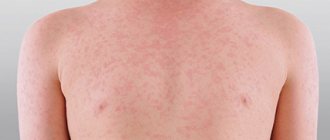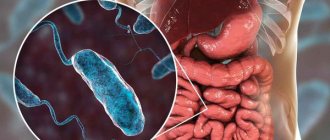Typhus
The incubation period can last from 6 to 25 days, most often 2 weeks. Typhus occurs cyclically, in its clinical course there are periods: initial, height and convalescence. The initial period of typhus is characterized by a rise in temperature to high values, headache, muscle aches, and symptoms of intoxication. Sometimes prodromal symptoms may occur before this (insomnia, decreased performance, heaviness in the head).
Subsequently, the fever becomes constant, the temperature remains at 39-40 ° C. On days 4-5, a decrease in temperature may be observed for a short time, but the condition does not improve, and the fever subsequently resumes. Intoxication increases, headaches, dizziness intensify, disorders of the sensory organs (hyperesthesia), persistent insomnia, sometimes vomiting, dry tongue coated with a white coating occur. Impaired consciousness develops up to twilight.
On examination, hyperemia and swelling of the skin of the face and neck, conjunctiva, and scleral injection are noted. The skin is dry and hot to the touch, from the 2-3rd day positive endothelial symptoms are noted, and on the 3-4th day the Chiari-Avtsyn symptom is detected (hemorrhages in the transitional folds of the conjunctiva). On days 4-5, moderate hepatosplenomegaly develops. Increased fragility of blood vessels is indicated by pinpoint hemorrhages of the palate and pharyngeal mucosa (Rosenberg enanthema).
The height of the period is characterized by the appearance of a rash on the 5-6th day of the disease. In this case, constant or remitting fever and symptoms of severe intoxication persist and worsen, headaches become especially intense and throbbing. Roseolous-petechial exanthema manifests itself simultaneously on the trunk and limbs. The rash is thick, more pronounced on the lateral surfaces of the torso and internal limbs, localization on the face, palms and soles is not typical, as are subsequent additional rashes.
The coating on the tongue becomes dark brown in color, progression of hepatomegaly and splenomegaly (hepatolienal syndrome) is noted, constipation and bloating often occur. In connection with the pathology of the renal vessels, pain may be observed in the area of their projection in the lumbar region, a positive Pasternatsky sign (pain when tapping), oliguria appears and progresses. Toxic damage to the ganglia of the autonomic innervation of the urinary organs leads to atony of the bladder, lack of reflex to urinate, and paradoxical diabetes (urine is excreted drop by drop).
At the height of typhus, an active development of the bulbar neurological clinic occurs: tongue tremor (Govorov-Godelier symptom: the tongue touches the teeth when protruding), speech and facial expression disorders, smoothed nasolabial folds. Anisocoria, nystagmus, dysphagia, and weakened pupillary reactions are sometimes noted. Meningeal symptoms may be present.
Severe typhus is characterized by the development of typhoid status (10-15% of cases): a mental disorder accompanied by psychomotor agitation, talkativeness, and memory impairment. At this time, further deepening of sleep and consciousness disorders occurs. Shallow sleep can lead to frightening visions, hallucinations, delusions, and forgetfulness.
The period of the height of typhus ends with a decrease in body temperature to normal levels after 13-14 days from the onset of the disease and relief of symptoms of intoxication. The period of convalescence is characterized by the slow disappearance of clinical symptoms (in particular from the nervous system) and gradual recovery. Weakness, apathy, lability of nervous and cardiovascular activity, memory impairment persist for up to 2-3 weeks. Sometimes (rather rarely) retrograde amnesia occurs. Typhus is not prone to early recurrence.
Causes
The pathogenesis of the rash type begins with the penetration of pathogenic bacteria from the genus Rickettsia into the body. They are nonmotile gram-negative intracellular parasites. The route of transmission of the disease is transmissible, from an infected person to a healthy person. The carrier is the louse.
There are several types of diseases: epidemic, endemic and tick-borne. Epidemic typhus is called classical; its causative agent is Provacek's rickettsia.
Endemic typhus predominates in countries with warm climates in the summer. Clinically it occurs in a milder form. Infection occurs through the bites of rat fleas.
Tick-borne typhus is caused by rickettsia (Rickettsia sibirica), which is transmitted through tick bites. Found in the Far East and Siberia. The etiology of tick-borne typhus is different from others; Rickettsia sibirica contains a toxic substance and can multiply not only in the cytoplasm, but also in cell nuclei. Infectivity increases in the spring-summer period, sometimes remaining at a high level until October.
If the skin is damaged, the penetration of rickettsia into the blood can occur in less than 15 minutes. The incubation period is 10–14 days, in the case of the tick-borne species – 4–6 days.
Pathogenesis and pathological anatomy
Having penetrated from the feces of an infected louse through a scratch, a skin crack or a bite site into the human blood, rickettsiae are spread throughout the body. Being intracellular parasites, they infect the endothelium of arterioles and capillaries, causing the development of characteristic histological changes here. Along with endovasculitis and the formation of blood clots, destruction of small vessels, stasis and hemorrhage are observed. Specific typhus granulomas are also characteristic - clusters of cells surrounding a small blood vessel like a sleeve.
The listed vascular changes are observed in various organs and tissues, but they are especially pronounced in the medulla oblongata and in other parts of the central nervous system, including the cerebral cortex. This explains the presence of a number of clinical symptoms from the nervous system, circulatory disorders and the development of meningoencephalitis - factors that determine the most important manifestations of the disease.
Due to similar changes in the small blood vessels that supply the nodes of the sympathetic and parasympathetic nervous system, a number of autonomic functions are disrupted, including metabolism and peripheral circulation. The development of specific thromboendovasculitis and blood stasis in arterioles and capillaries explains the formation of roseola and petechiae on the skin, appearing from the 4-5th day of illness.
All these disorders in the patient’s body are intensified due to specific intoxication caused by metabolic products of pathogens: Provachek’s rickettsia toxins inhibit the activity of the nervous system and cause paresis of blood vessels. Under the influence of pathogen toxins in patients with typhus, blood circulation in the arterioles and capillaries is disorganized, which is especially pronounced in the central nervous system.
#4. Other diseases that occur after a tick bite
The above diseases do not complete the list of all diseases that are transmitted by a tick bite. In addition to them, there are numerous fevers :
- Omsk hemorrhagic fever
- West Nile fever
- Q fever
- Crimean-Congo hemorrhagic fever
- Marseilles fever and others
All of them are found on the territory of Russia in certain areas where ticks live. In addition, there is a disease called babesiosis. It is also transmissible, i.e. transmitted by the bite of blood-sucking insects. Several specific diseases also occur in animals . For example, theileriosis, various types of rickettsiosis and others.
Thus, the list of diseases that can be contracted from a tick bite is quite extensive. Therefore, when attacked by a parasite, you need to be vigilant and be attentive to the state of the body after the bloodsucker attack . So be extremely careful and take care of your health!
Useful articles about ticks:
– How do ixodid ticks attack?
– Do I need to be vaccinated against ticks?
– Features of ixodid ticks: what do you need to know?
Prevention
After hospitalization of the patient, the prevention of typhus consists of carrying out disinsection, disinfection and anti-pediculosis measures at the source of the disease. It is necessary to identify those who were in contact with an infected person, and the source of infection itself, and conduct laboratory tests.
A patient who has suffered from the disease needs to be observed by specialists for some time.
When preventing tick-borne typhus, you should fight ticks: use repellents, wear special equipment, or, in the absence of such, sew protective elements into regular clothing.
Diagnostics
Making a diagnosis in the first days of clinical manifestations is difficult, since laboratory diagnosis of typhus using a serological reaction with a specific antigen can show a positive result from the 4th to the 7th day of the disease.
They examine the patient, collect anamnesis, check for bites on the body and the nature of the rash. On palpation, the liver and spleen are enlarged. General and biochemical blood tests, general urinalysis, and coagulogram are prescribed.
In differential diagnosis, the disease is distinguished from measles, syphilis and pneumonia.
#3. Ehrlichiosis
Another fairly common disease that occurs after a tick bite. It is especially common in dogs. However, humans are also susceptible to it.
Ehrlichiosis is caused by Ehrlichia bacteria. A specific feature of the disease is that it can be accompanied by simultaneous infection by microbes of other diseases , forming a whole “bouquet” of manifestations in the body.
Moreover, in each case the symptoms of the disease are very different. This often makes it difficult to make an accurate diagnosis. Therefore, the fact of a tick bite must be kept in mind for at least a month. Sometimes this helps to clarify the clinical picture and choose the right direction of treatment as quickly as possible.
Symptoms of ehrlichiosis
The incubation period of the disease lasts up to three weeks. Sometimes more. However, the first signs may appear the next day after a tick bite . The initial symptoms are very similar to other infectious diseases. In particular, with tick-borne diseases. It is accompanied by:
- febrile conditions,
- headaches,
- nausea and bouts of vomiting,
- general weakness
- muscle pain,
- intoxication of the body,
- rash.
Other manifestations of ehrlichiosis are very extensive and may be similar to many other infectious diseases. There are no specific signs characteristic only of this disease . To the point where sometimes symptoms are almost completely absent. The diagnosis is made only after blood tests and other tests.
However, in any case , if at least some of the above symptoms appear after a tick bite, it is important to immediately see a doctor . It is better to take a course of antibiotics in advance than to allow the infection to irreversibly damage the body. And the harm in the absence of timely treatment can be very extensive: from dysfunction of internal organs and numerous bleeding to coma . The specific action of the bacteria that causes ehrlichiosis is a decrease in blood clotting. Therefore, with the slightest violation of the integrity of the integument and organs, significant blood losses can be life-threatening. You need to remember this!
Treatment of ehrlichiosis
Ehrlichiosis, like other tick-borne diseases, is treated with antibiotics in combination with other types of therapy. In this case, treatment often occurs without hospitalization, under the supervision of a doctor. However, self-medication in this case is strictly prohibited!
Only a doctor will be able to select the right antibiotic that can affect the cause of the disease and kill ehrlichia. Self-selection of medications may not only not help, but, on the contrary, aggravate the course of the disease and lead to numerous complications .
Rickettsia Provacek
The causative agent of the disease is Provacek's rickettsia, which are microorganisms that parasitize the endothelial cells of blood capillaries. Under natural conditions, Provacek's rickettsia multiply in the endothelial cells of the blood capillaries of a sick person and in the epithelial cells of the intestinal wall of lice infected with them. Rickettsia can be cultivated in the lung tissue of white mice and on the chorion-allantoic membrane of a chicken egg embryo, which is used to obtain vaccines against typhus (Durand and Cox vaccines). Rickettsia quickly die in a humid environment, but persist for a long time in lice feces and in a dried state. They die at a temperature of 100 degrees, under the influence of conventional disinfectants.
Complications
Among the possible complications of typhus, one should first of all note trophic tissue lesions (skin necrosis, bedsores) and thrombophlebitis (the veins of the lower extremities are most often affected). Some patients, especially those with previous exhaustion of the body or poor oral care, may develop purulent parotitis. Sometimes limited bilateral focal pneumonia develops; Otitis is possible in children. Toxic neuritis of the auditory nerve is not uncommon, although in these patients soon (usually by the time of discharge from the hospital) hearing acuity is completely restored. In some severe cases, the development of typhus meningoencephalitis is observed. The disease leaves behind some immunity and no relapses are observed.
#2. Tularemia
Another fairly common disease in Russia and other countries, transmitted by a tick bite. At the same time, attacks by infected arthropods are not the only way of transmitting the disease . It can be distributed:
- in direct contact with sick animals (living or dead),
- through contaminated food and water,
- and also through inhalation of air containing pathogenic organisms.
Tularemia is caused by the bacteria Francisella tularensis. These microorganisms can live not only inside living organisms. They quite successfully maintain their viability on vegetation, straw, and grain .
Development of tularemia
The incidence of illness when bacteria enter the body is very high . Almost no one avoids developing the disease after the tularemia bacillus enters the body. The hidden period can last up to 30 days . However, most often within a week after a tick bite, tularemia makes itself felt.
The symptoms of the disease are as follows (many of them are similar to those of tick-borne typhus):
Lymph node involvement
- sudden increase in temperature, fever;
- intoxication, loss of strength;
- pain in the body and head;
- extensive inflammation of the mucous membranes;
- rash;
- slow heart rate,
- lowering blood pressure,
- enlarged liver and spleen.
The lymph nodes are very affected . They swell and suppurate, forming so-called buboes. Some can reach up to 5 cm in diameter. Other signs of the disease may vary greatly depending on the type and source of infection.
Treatment and prevention of tularemia
Therapy is carried out with antibiotics, both specific and broad-spectrum. Additionally, intravenous detoxification procedures are carried out to relieve and alleviate the state of intoxication of the body. When the lymph nodes suppurate, they are opened and cleaned. If necessary, antipyretic drugs, vitamin supplements and other medications are used.
To prevent the development of tularemia, I often use vaccination . The vaccine is valid for five years or more. Therefore, it is often used in areas with an increased risk of transmission of tularemia bacilli due to a tick bite or contact with other sources of infection.






